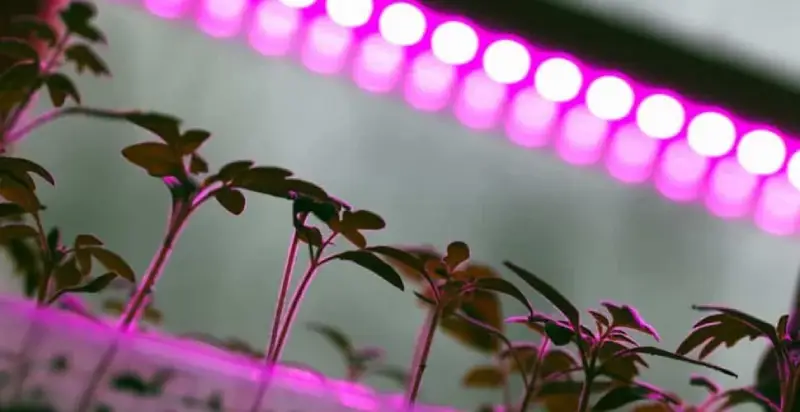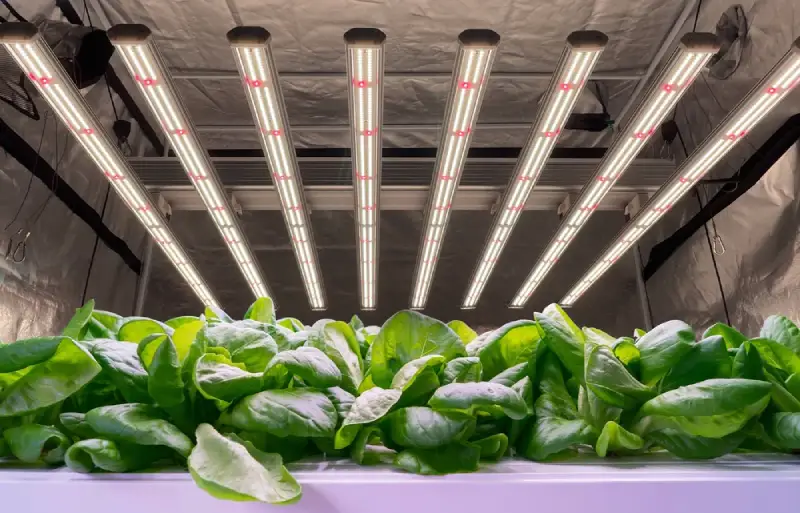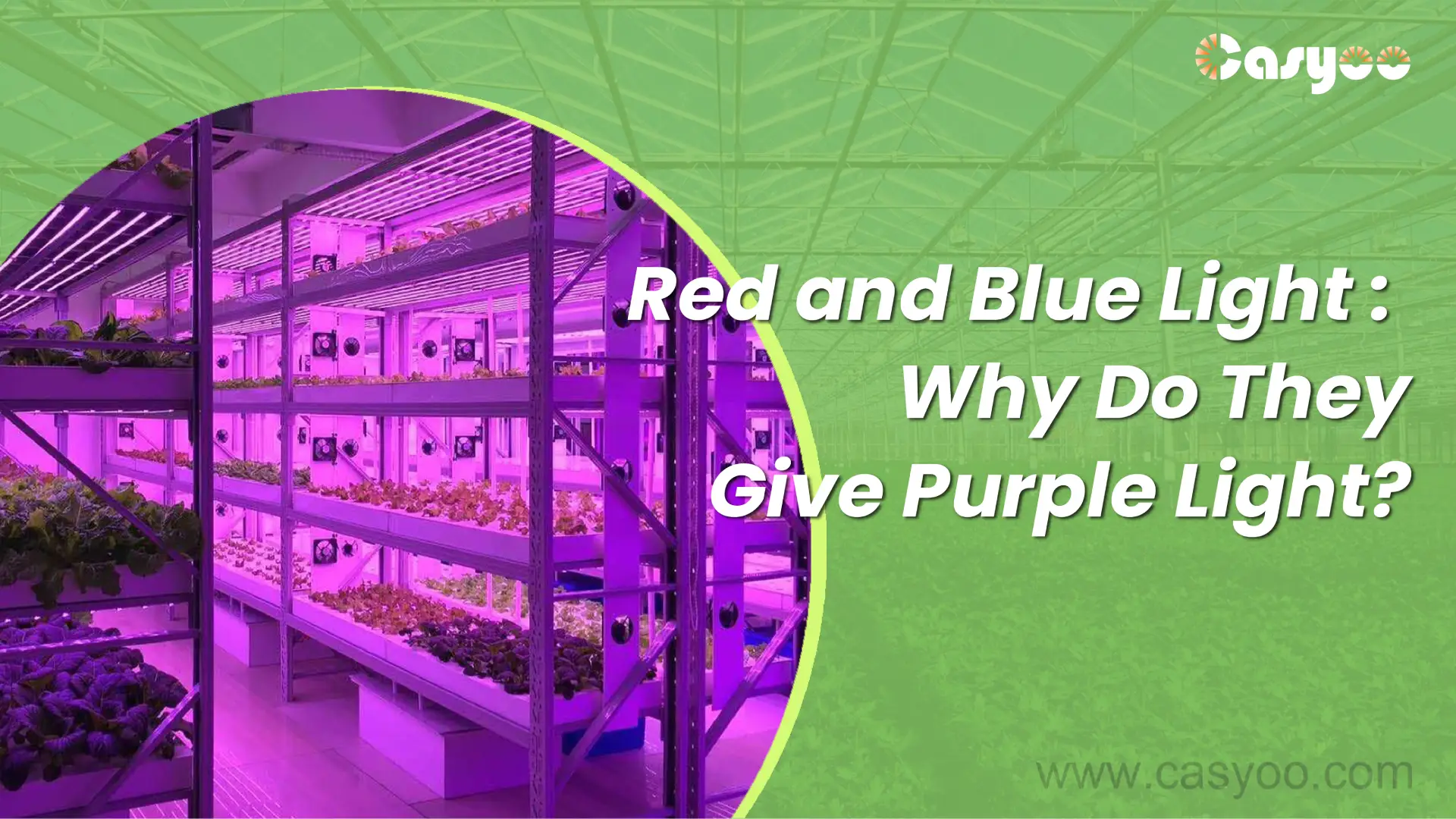Do you know that the white or orange light produced by HPS and MH bulbs is not as beneficial for plant growth as the red and blue light produced by LED grow lights?
LED lights combine red and blue LEDs to produce a purple light. It is important for farmers around the world to understand the science behind why red and blue light emit purple light and how it helps plants grow.
Why are some LED grow lights purple?

The combination of the red and blue wavelengths is what gives LED lights their purple light. Plants absorb red and blue wavelengths the most for photosynthesis, making this spectrum combination the most energy-efficient for plant growth as well.
From this perspective, if growers have access to sunlight, it makes a lot of sense to devote most of their energy to the wavelengths that are most conducive to photosynthesis, maximizing energy savings. Red and blue LEDs have the best photon efficiency than other spectra. This means more electricity can be turned into photons. Thus red and blue LEDs are more energy-efficient than full spectrum lighting.
Red light
Red light controls growth, promoting the health of plants. Plants that receive more red light tend to grow higher and have longer stems. Plants can get the most energy from red light. So plants that get red light also experience a faster rate of photosynthesis.
Blue light
It is also beneficial for plant growth. Blue light, like red light, aids in development regulation. Blue light-exposed plants typically grow shorter, fatter, and with shorter stems. Compared to plants that don’t receive enough blue light, these plants have substantially bigger, dark green leaves.
Why use a combination of red and blue light to grow plants instead of just red or blue LEDs?
While red light is most effective for photosynthesis, only red light causes poor plant growth, such as elongated stems, so blue light is added to keep the plant compact and more typical in shape. On the other hand, plants cannot be grown only under blue light. Their growth and development will also be adversely affected.
Over the years, researchers have found that a ratio combination of high red and low blue light has proven to be optimal for greenhouse crops that already receive sunlight. Since there is no so-called “ideal spectrum” for greenhouse crops, the fixed red-blue ratio provided by most LED manufacturers has been considered to be the best ratio for horticultural crop growth and production.
When should I use red and blue light?
Blue light affects the way plants produce chlorophyll and get nutrients. Red light, on the other hand, encourage flowering and photosynthesis, which makes plants produce more chemicals at a faster rate.
This means that plants need more red light than blue light. However, make sure to increase the amount of blue light if you are growing plants that are acclimated to low light circumstances or if you wish to place them where there is less daylight.
Most plants benefit from red and blue light during the vegetative stage. The plant generates the greatest amount of leaves and stems during this time. The growth of plants depends on how much of your spectrum is red or blue. If you want to grow smaller, more compact plants, make sure to expose them to more blue light. But turn the red light when it comes to flowering and bearing fruit. When the seeds germinate, it is best to ensure that the spectrum has a more red light.
What about full spectrum LED grow lights?

While red and blue grow light can sustain a plant throughout its life cycle, you may want to include other colors at certain growth stages to help improve quality and growth rate. This means that you should use a full spectrum LED.
In greenhouses, outdoor sunlight will cancel out the purple light emitted by red and blue LED lights. Red and blue LED, as a single light source in indoor applications, provides a very limited spectrum to the plant. Plus, working under this light can be very uncomfortable. Consequently, many farmers have switched to full spectrum LEDs.
Due to energy and optical losses during conversion, full spectrum LEDs are less energy efficient than red and blue LEDs. Full spectrum lights, on the other hand, are superior than red and blue LEDs as the sole light source in indoor agriculture since they can emit a broad range of wavelengths at various stages. This is the crux of the matter. As more and more research goes on, growers find that wavelengths like green light, which were previously not thought to be very useful, turn out to be important in photosynthesis and some plant morphological reactions. In addition, many full spectrum LED lights can emit far infrared light, promoting the extension of plant stems and leaves.
In an environment with only red and blue light sources, the human eye will not be able to correctly identify nutritional deficiencies, pests and diseases. however, a full spectrum LED not only makes the plants pleasing to the eye, but also makes indoor planting and evaluation work easier. Therefore, although the red and blue LED can be used as a single light source, it will affect human health and the working environment, so we strongly recommend the use of full spectrum LED grow lights.
Is there an ideal spectrum for plant growing?
The ideal spectral range for a plant depends largely on the use scenario and what the grower wants to achieve. Therefore, there is no ideal spectrum because plants react differently to various wavelengths.
The best way to find out how plants are doing is to set up a pilot area to test how different species respond. Since growth characteristics can be controlled through different spectra, it is necessary to know which growth characteristics are most important to the grower.
Since most growers want to ultimately achieve higher yields and quality, a specialized spectrum is not necessarily required. In general, the spectrum of many LED grow light brands is optimized for yield and quality for plant growing. So the plant can choose the desired wavelength according to its needs.
You might also ask, is it necessary to have different spectra for different growth stages? In the previous era of HPS lamps, the industry usually recommended MH bulbs for veg phase and HPS lights for the flowering phase. For LED lights, however, two different spectra are not necessarily required. At these stages, what is more important is the duration of light and the light intensity. As plants go from reproduction to growth to flowering, light intensity should be increased for maximum yield, quality and productivity. As we all know, light intensity is highly correlated with yield and overall quality.
About us
Our full spectrum lights have the optimal balance of spectrum, ensuring your plants grow healthily from germination through flowering. If you have any questions about plant growing, please feel free to contact us.




